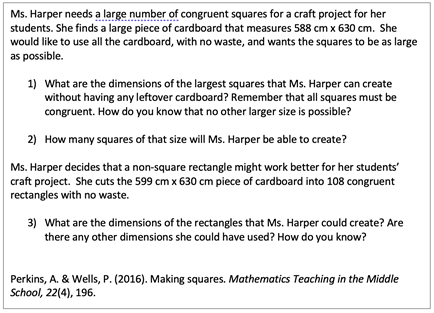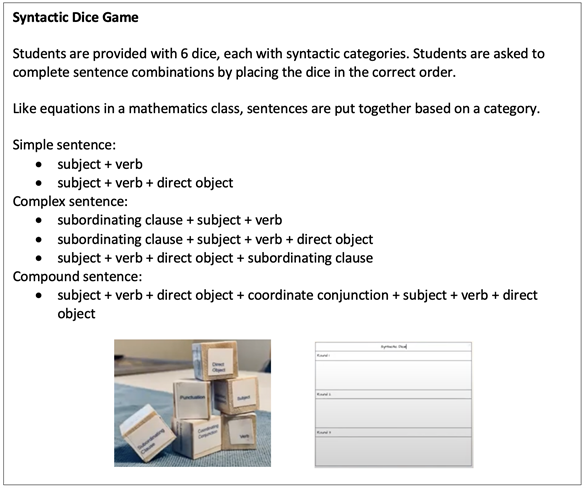Creating Opportunities for Productive Struggle in Math, ELA, Social Studies, and Science
While productive struggle has been the focus of much research for the past two decades (e.g., Ewing et al., 2019; Hiebert and Grouws, 2007; Townsend et al., 2018), much of that research centered on mathematics content. Here we posit that productive struggle can, and should, be an aspect of curricula across all content areas. From a mathematical perspective, productive struggle requires students to “expend effort to make sense of mathematics [in order] to figure something out that is not immediately apparent” (Hiebert & Grouws, 2007, p. 387). Dewey (1910) proposed that deep understandings only develop through struggle with the content. Building upon Dewey’s perspective and removing the math-only focus of productive struggle, we define productive struggle as a learning opportunity that students participate in when required to apply prior knowledge to challenging tasks, learning from their mistakes in the process. By this definition, providing opportunities for productive struggle supports the essential attributes of AMLE’s The Successful Middle School: This We Believe that an education for young adolescents be challenging, empowering, and engaging (Bishop & Harrison, 2021).
Several vital components must be present to maximize the benefits of productive struggle. While the struggle supports more profound learning, there is a fine line between productive and unproductive struggle. Furthermore, this line is dynamic, not static; it can, and will, change daily for students and is dependent upon the task presented and outside factors faced by the student (e.g., friend or family issue). Students can be supported through the struggle via purposeful questioning to scaffold the student. Teachers can also support productive struggle by praising perseverance rather than correcting answers and pointing out the positives of students’ incorrect strategies. To maximize the benefits of productive struggle, students and teachers must possess a growth mindset (Dweck, 2006) – the understanding that success is proportional to effort expended. Opportunities for productive struggle must be consistent within and among classes, making it necessary to understand how to incorporate productive struggle in each content area. In the next section, we share our strategies for providing opportunities for struggle.
Productive Struggle in Mathematics
Opportunities for productive struggle can be presented through challenging problems solvable independently or in groups of 2-3 students. When students work collaboratively, they can share ideas and solution strategies, which will often improve their perseverance devoid of teacher support. Figure 1 shows a question used in a mathematics class, but any problem that provides a challenge and requires application of prior knowledge applies. Problems that incorporate many different concepts can be the most beneficial to student learning and concept application; students benefit from experiencing the connectedness of mathematics topics. In addition to the problem shown below, opportunities for productive struggle exist among logic problems, Ken-Ken puzzles, or “Problems to Ponder” which can be found in the National Council of Teachers of Mathematics journal, Mathematics Teacher: Learning and Teaching PK-12.
Figure 1
Example of a productive struggle math problem.

Productive Struggle in ELA
In ELA classrooms, productive struggle can be incorporated in grammar instruction. Students are tested on grammatical concepts yearly; yet, many still lack understanding of basic English language structures (e.g., linking verbs, direct objects, etc.). Developing an understanding of language structure is necessary when determining genre, defining language as figurative and literal, and determining the meaning of literary and rhetorical devices. Two strategies for incorporating productive struggle within grammar instruction are sentence diagramming and a syntactic dice game (see Figure 2).
Figure 2
Syntactic Dice can foster productive struggle in learning grammatical structures.

Additional resources include Grammar to Get Things Done (Crovitz & Devereaux, 2017), More Grammar to Get Things Done (Crovitz & Devereaux, 2017), and Grammar Revolution – each include exercises that can be incorporated into your classrooms.
Productive Struggle in Social Studies
A major challenge in supporting student understanding in Social Studies is developing students who can think like historians. Historical thinking requires students to think about history in a way different from how they ordinarily think, going against what they learn from popular culture/history (Wineburg, 2001). One strategy to overcome this obstacle is using resources from the Stanford History Education Group. This resource supports historical thinking by teaching history through inquiry and building upon prior knowledge and understandings; the information is available for various grade levels and easily accessible for students. Another strategy for supporting historical inquiry is the SCIM-C strategy (summarizing, contextualizing, inferring, monitoring, and corroborating). This strategy allows students to evaluate historical sources while providing a means of scaffolding to support the productive struggle.
It is essential to require students to do the work by having them struggle productively as they imagine historical events outside of their 21st Century lens. Additional resources to support productive struggle include Newsela, DocsTeach, Library of Congress, or Thinglink.
Productive Struggle in Science
Productive struggle is the essence of science as the scientific process is a form of productive struggle. The nature and practice of science allow individuals to understand what science is, how it works, and what it does and does not explain; it begins with a problem and enables everyone to bring their knowledge and experiences to the table to solve a problem or explain a phenomenon.
It is crucial to engage students in an active learning process; students should be doing science, not just acting as vessels to absorb given information. Students should engage in science through inquiry, discovery, and making observations. These practices should then lead students to design experiments and solve challenges, such as those presented by NASA or Science Buddies. This positions students to pull information from their experiences, interests, and understanding and provides open-ended problems that create opportunities for productive struggle, as there may not be one correct answer or a specific process to follow.
Conclusion
Productive struggle is vital to learning in all content areas. Productive struggle requires a growth mindset that supports critical thinking, meaningful connection-making among content topics, and perseverance. This article provides some strategies and resources to incorporate opportunities for students to productively struggle, such as challenging math problems, collaborative sentence development, thinking like a historian, or investigating phenomena as a scientist. However, there are many more ways to create opportunities for productive struggle in each content area that will benefit student learning and resilience.
Shelli Casler-Failing is an Assistant Professor at Georgia Southern University
Taylor Norman is an Assistant Professor at Georgia Southern University
Elizabeth Barrow is an Assistant Professor at Georgia Southern University
Amanda Glaze is an Associate Professor at Georgia Southern University
References
- Bishop, P. A. & Harrison, L. M. (2021). The successful middle school: This we believe. Association for Middle Level Education.
- Crovitz, D. & Devereaux, M. D. (2017). Grammar to get things done. Routledge and National Council of Teachers of English.
- Crovitz, D. & Devereaux, M. D. (2020). More grammar to get things done. Routledge and National Council of Teachers of English.
- Dewey, J. (1910). How we think.
- Dweck, C. S. (2006). Mindset: The new psychology of success.
- Ewing, J., Gresham, G. J., & Dickey, B. (2019). Pre-Service teachers learning to engage all students, including English Language Learners, in productive struggle. Issues in the Undergraduate Mathematics Preparation of School Teachers: The Journal, 2, 1-11. https://eric.ed.gov/?id=EJ1206251
- Hicks, D., Doolittle, P., & Ewing, T. (2022). SCIM-C: Historical inquiry. http://www.historicalinquiry.com/
- Hiebert, J., & Grouws, D. A. (2007). The effects of classroom mathematics teaching on students’ learning. In F. Lester (Ed.), Second Handbook of Research on Mathematics Teaching and Learning (pp. 371-404). Information Age.
- KenKen Puzzle. (2021). KenKen puzzle official site. http://www.kenkenpuzzle.com/#
- Library of Congress. (n.d.). Education resources from the Library of Congress. https://www.loc.gov/education/
- (2009). NASA for students in 5th to 8th grade. https://www.nasa.gov/stem/forstudents/5-8/index.html
- National Archives. (n.d.). DocsTeach: The online tool for teaching with documents. https://docsteach.org/
- (2022). High quality social studies content for everyone. Newsela Social Studies. https://newsela.com/about/products/social-studies/
- O’Brien, E. (2022). Grammar revolution: Teach and learn grammar the easy way. Grammar Revolution. https://www.english-grammar-revolution.com/
- Puzzle Baron. (n.d.). Puzzle Baron’s logic puzzles. https://logic.puzzlebaron.com/init.php
- Science Buddies. (2022). Middle school science experiments. https://www.sciencebuddies.org/science-experiments/middle-school
- Stanford History Education Group. (n.d.). Reading like a historian. History Lessons. https://sheg.stanford.edu/history-lessons
- (n.d.). ThingLink for teachers and schools. https://www.thinglink.com/
- Townsend, C., Slavit, D., & McDuffie, A. (2018). Supporting all learners in productive struggle. Mathematics Teaching in the Middle School, 23(4), 216-224. https://doi.org/10.5951/mathteacmiddscho.23.4.0216
- Wineburg, S. (2001). Historical thinking and other unnatural acts: Charting the future of teaching the past. Temple University Press.

The struggle sure is real. I’m currently studying to become an ELA Middle Grades teacher and the thing that many students do not want to learn in the classroom and despise with their whole being is grammar. Because grammar is one of the most despised things to learn within ELA classrooms, the productive struggle is necessary for students to learn on their own and use their schema to figure out their dilemmas. Not only are we building students’ struggles with grammar and grammatical skills, but we are also building their out-of-classroom social and communication skills as well. When we struggle, we want to give up, during this instructional approach I think it should be noted that students need support in ways that do not give them the solution. “Give it your best try.”, “You’re on the right track!”, and more supportive comments will help students understand that you do not want them to be masters of a topic on their own, but just want to see where they can get with their previous knowledge on the subject.
As someone who is studying to become a Secondary Social Studies teacher, I can see when students are struggling to understand the information. Currently, in my practicum class, the students in the class that I observe are learning to write a research paper and a bunch of them look defeated. One of the most tedious things to do when writing a paper is having to cite your sources and unfortunately the students are having a hard time with it. I tried and helped them as best as I could by providing them with the information and resources such as Purdue Owl to show them how to correctly write a citation in MLA formatting. By providing students resources like Purdue Owl, it gives them an opportunity to learn as they repeatedly look at how to correctly cite a source. Through that repetition, their schema will kick in and students will be able to process how to cite a source.